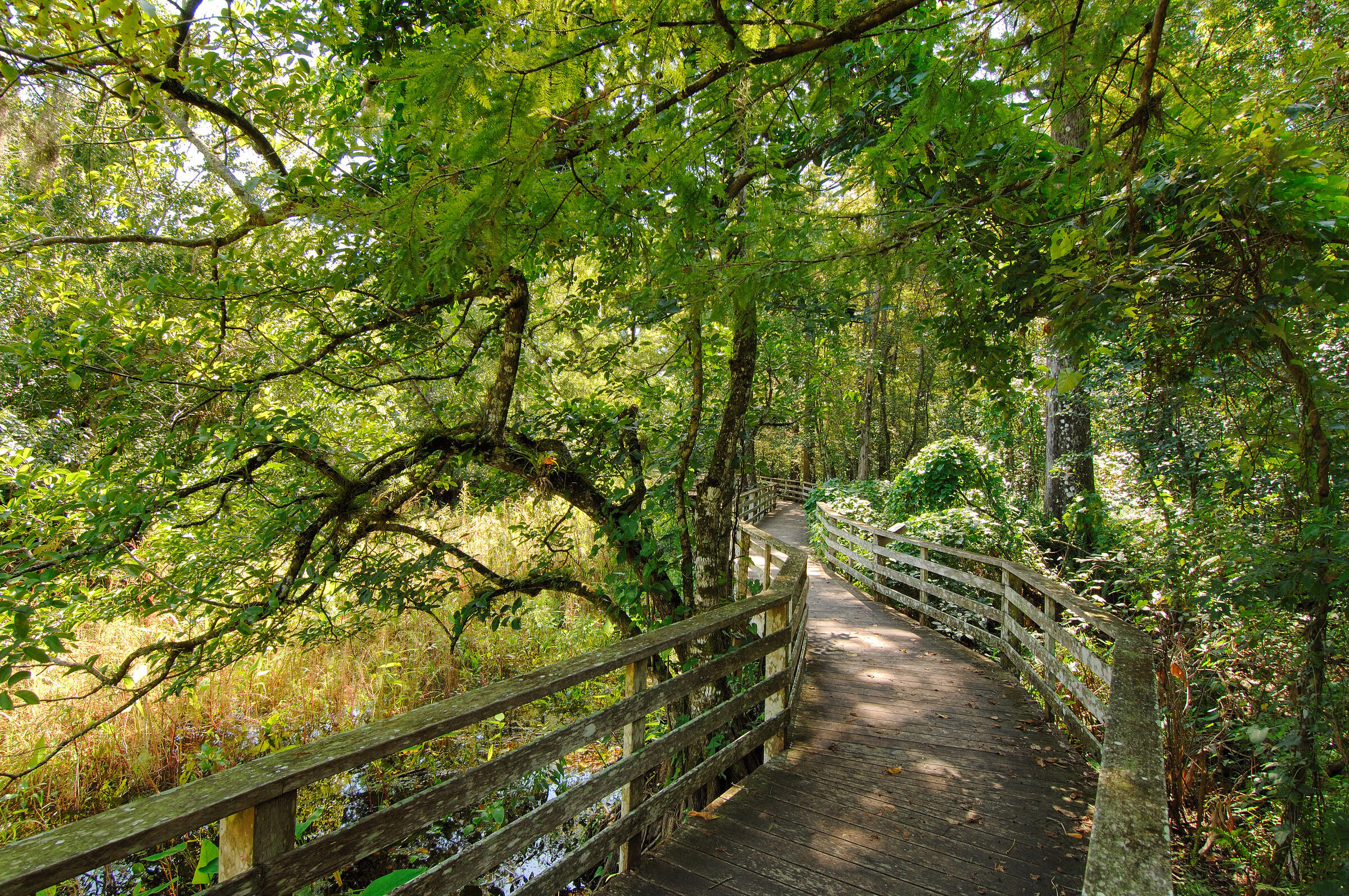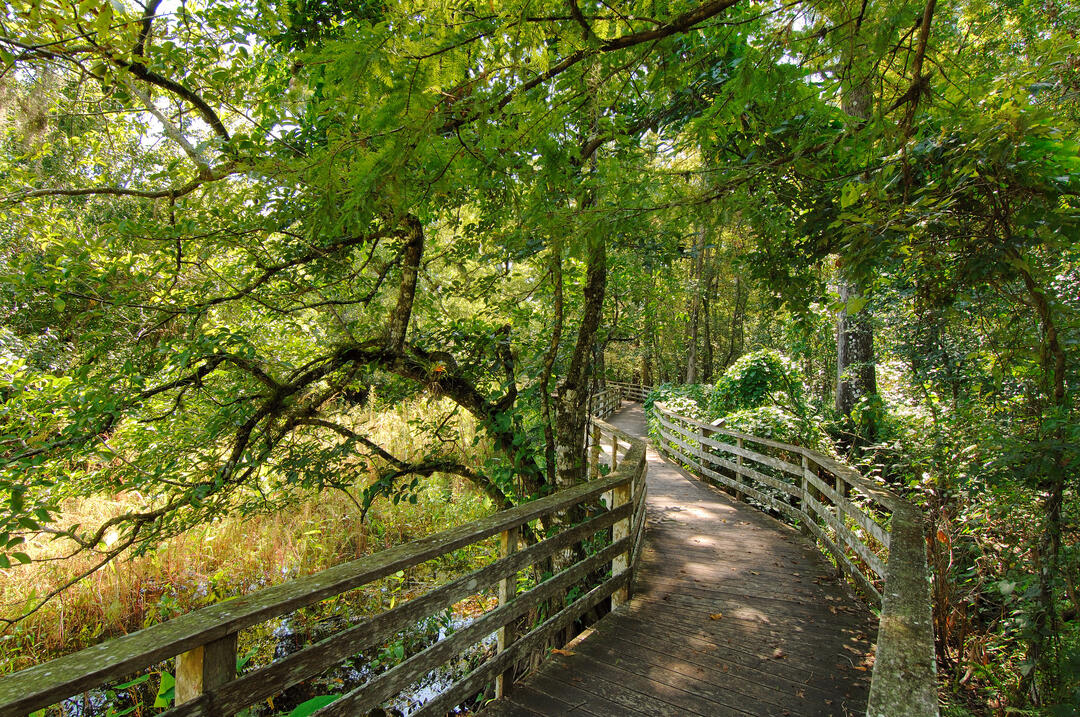Celebrating 70 Years of Wetland Conservation
Corkscrew Swamp Sanctuary occupies 13,000 acres in the heart of the Corkscrew Watershed in Southwest Florida, part of the Western Everglades. It is primarily composed of wetlands, including the largest remaining, virgin bald cypress forest in the world (approximately 700 acres), which was historically the site of the largest nesting colony of Federally Endangered Wood Storks in the nation. In addition to the Wood Stork, Corkscrew Swamp Sanctuary provides important habitat for numerous other Federal and State listed species, including the Florida panther, American alligator, gopher tortoise, Florida Sandhill Crane, Roseate Spoonbill, Snowy Egret, Tricolored Heron, White Ibis, Big Cypress fox squirrel, and the Florida black bear. Several rare plants are also found here, most notably the ghost orchid.
Our mission: To preserve Corkscrew Swamp Sanctuary and support the conservation and restoration of natural ecosystems throughout the Western Everglades. We use science-driven land management and education to protect birds, other wildlife, and people.
Corkscrew Swamp Sanctuary provides an important connection for wildlife and water to coastal habitat in the Estero Bay Aquatic Preserve and Delnor-Wiggins State Park via the Estero, Imperial, and Cocohatchee rivers. It also provides connectivity to important habitats in southeast Lee County as well as the Florida Panther National Wildlife Refuge and the Big Cypress National Preserve to the south via Camp Keais Strand.
The Sanctuary is in a strategically important location, and the quality of the natural resources here provides excellent habitat for wildlife. Our wetlands recharge the local aquifers, rivers, and estuaries, providing the right conditions for fishing and coastal recreation as well as clean drinking water and water for agricultural productivity.
A variety of battles over birds, lumber, water, and land spanning more than a century has transformed Southwest Florida. Much of the area bears little resemblance to its native roots, yet Corkscrew remains a vibrant wet wilderness. We are inextricably connected to our past and to our neighbors. The demand for resources and space presses on and in. Our ability to sustain some of our larger more charismatic creatures like the Wood Stork and Florida Panther is sure to be tested. We are a sanctuary for wild Florida, a living natural history repository open 365 days per year. We are committed to protecting and preserving this patch of ground for the benefit of the wild things that depend on Corkscrew. To do that, we need to be reminded of how we got here to begin with and be vigilant with regard to current and future threats to Corkscrew and its denizens.
A Brief History of Corkscrew Swamp
Plume Hunting
Up until the early 1900s few people outside of southern Florida had ever heard of Corkscrew. It was around this period when egret and heron plumes were in high demand for use in the fashion industry. Plume hunters could make a fortune in a well-timed weekend hunt and were quickly devastating rookeries throughout Florida and in the southeastern United States. The rookery at Corkscrew was among those targeted. Rhett Green was deputized and employed as a warden by the National Audubon Society. His responsibility was to guard and protect the Corkscrew rookery. By 1913, Rhett Green had begun serving as a guide for people like Thomas Gilbert Pearson, F.M. Phelps, Oscar E. Baynard, and W. F. Blackman who were documenting the bird life found at Corkscrew.
Pearson records the words of Audubon Warden Rhett Green regarding his encounter with plume hunters in his book "The Bird Study Book" ( Pages 210-211, 1917)
"Those 'long whites' are never off my mind for a minute," said the warden, as we paused to watch some fly over. "Two men came to my camp last week who thought I didn't know them, but I did. They were old-time plume hunters. They said they were hunting cattle, but I knew better—they were after Egrets and came to see if I was on guard. I told them if they saw anyone after plumes to pass the word that I would shoot on sight any man with a gun who attempted to enter the Corkscrew. I would do it, too," he added as he tapped the barrel of his Winchester. "It is terrible to hear the young birds calling for food after the old ones have been killed to get the feathers for rich women to wear. I am not going to have my birds sacrificed that way."
The full text of the book can be found online here.
The combination of rookery protection and a campaign to stop the demand for the plumes was successful. The plume hunters went away, and so did our wardens.
Logging
Systematic logging of South Florida cypress forests started in 1944 in the Fakahatchee strand south of Corkscrew. Much of the lumber went to assist in the rebuilding of Europe after WWII. By the early 1950's all of the Fakahatchee cypress had been logged, and Lee-Tidewater Cypress Company had moved north to Corkscrew. Networks of logging roads were constructed and massive 500-year-old trees were being pulled out. Locals were alarmed at the prospect of losing all the great cypress forests to logging and began a campaign to save the swamp. The National Audubon Society and a long list of organizations and individuals worked together to raise the support necessary to purchase the last expanse of virgin bald cypress left in the world, which also housed the largest and most important Wood Stork rookery in the United States. By 1954, 5,680 acres were secured (640 acres were a gift from Lee-Tidewater Cypress Company) and the Corkscrew rookery became Corkscrew Swamp Sanctuary.
Additional resources on Corkscrew's ecology and history:
Emerald Kingdom
The Acquisition and Development of the Corkscrew Swamp Sanctuary, 1952-1967
Sam Whidden's Recollections
The Early Sanctuary
In mid-February of 1953, National Audubon Society (Audubon) president, John H. Baker, laid out the value and purpose of Corkscrew Swamp in an article published in the Miami Herald. Baker urged Florida Governor Dan McCarty to enlist the state to acquire "the great Corkscrew rookery of wood ibis (storks) and American egrets in the beautiful strand of virgin cypress between Immokalee and Bonita Springs" explaining that it was an example of outstanding scientific and esthetic value. He further suggested that some manner of public use be employed that would allow the protection of the scenery, wildlife, vegetation, and other historical values.
Nearly two years later, in the absence of any state interest in managing the swamp, Audubon took ownership of this great Corkscrew rookery. The initial Sanctuary was 5,680 acres. We eventually grew, adding an additional 5,320 acres, the latest acquisition was the Panther Island Mitigation Bank. Our fledgling sanctuary was accessible only by four-wheel drive vehicles along a remote dirt road. Henry (Hank) P. Bennett was the Audubon warden hired to be our first nature interpreter for visitors to the swamp. The tour consisted of Hank pushing tourists through the lettuce lakes in canoes. This was a modest but exciting precursor to our current excellent education department. It would be another year before the first stretch of the boardwalk would be constructed. Around this time, a chickee was erected to serve as the welcome station for visitors. The dirt road became pavement. Electricity and phone lines came, and before long a neighborhood sprung up next to Corkscrew on the east. With neighbors came a need for fences and heightened vigilance concerning invasive plants, leading to the establishment of our resource management department.
Our Changing Neighborhood
Along with the increase in roads came an extensive network of canals, ditches, and berms, and a lot more people. Wetlands were drained and filled, water was diverted, and the way was cleared for extensive agriculture. Wetlands gave way to orange groves and fields of row crops, and eventually neighborhoods. By the mid 1970's the hydrology of Southwest Florida had been transformed. A comparison of the pre-development habitat map with the 2004 habitat map of southwest Florida clearly illustrates the dramatic changes.
For obvious reasons, development pressure has affected native upland habitats and shallow wetlands far more than the deep wetlands, which are harder and more expensive to drain and fill. This has taken a harsh toll on a broad spectrum of wildlife, most notably, on Wood Storks and panthers. While the introduction of Texas cougars has resulted in gains in the panther population, no elixir has been found to cure the ills of the Wood Stork in Southwest Florida. Our Wood Stork's nesting area is secure, but their far-flung feeding grounds remain vulnerable to development impacts, leaving the colony very unstable. Follow the wood stork link for more information on the plight of this endangered species.
In response to the widespread wetland impacts, a visionary group of individuals began advocating for the protection of the watershed surrounding Corkscrew Swamp. The result was a County/State partnership committed to a willing seller acquisition program of the Corkscrew watershed. Acquired lands are managed by the South Florida Water Management District; the area is called the Corkscrew Regional Ecosystem Watershed, or CREW. The success of this program has gone a long way towards securing our natural wetland hydrology and acts as a buffer against further development impacts.
Our Future
We put a halt to plume hunting, we saved the old-growth bald cypress, and most of our upstream and much of our remaining downstream watershed is designated as conservation land. However, threats to Corkscrew remain, and we work very hard to maintain and restore the natural history legacy entrusted to us.
More than ever, we are dependent on support and partnerships with private citizens, neighbors, elected officials, and folks making land use decisions. We place a premium on educating all who will listen on the value of Corkscrew Swamp and natural areas.
How you can help, right now
Donate to Protect Corkscrew's Birds and Wetlands
Make a meaningful and lasting gift to protect Corkscrew Swamp Sanctuary's rare Everglades habitat.
Become a Member
Join an extraordinary and growing community of members dedicated to supporting the conservation of natural ecosystems throughout the Western Everglades.
Sign Up for the Corkscrew eNewsletter
Stay connected to Corkscrew Swamp. Sign up for our monthly online newsletter.





